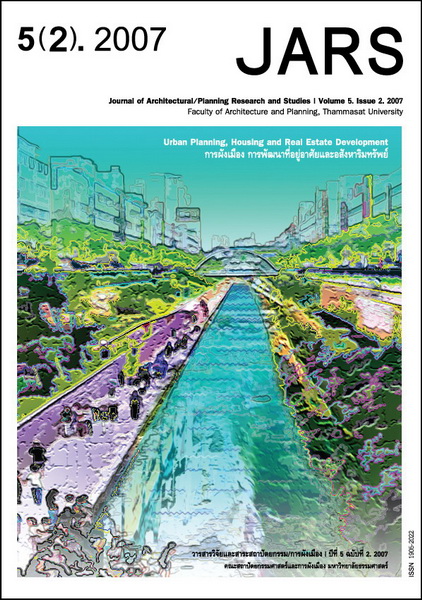Arts and the Quality of Thammasat University Students’ Lives: A Case Study of Faculty of Architecture and Planning, Faculty of Applied Arts, and Faculty of Journalism and Mass Communication
Main Article Content
Abstract
This research aims to study variables in art giving effects to students’ living quality, including relationship and development between art and students’ quality of life. Findings are expected to give suggestions on bringing art as a tool to develop students’ living quality in Thammasat University. Research methodology is quantitative research using questionnaire surveys on art-related faculties that are Faculty of Architecture and Planning, Faculty of Applied Arts, and Faculty of Journalism and Mass Communication, with 600 respondents from sampling of undergraduate students from the three faculties in equivalence. According to the findings, art-related activities with proximity to recreation of students’ life such as listening to music, watching television, playing internet, watching movie, and drawing picture are activities which students can use spaces or facilities inside the university. Other activities do not show much frequency, but also give satisfaction in high level. Concluding from the study on roles of art and its effects on quality of life, the findings show that even most students have high satisfaction in living quality and agreement on art as a tool for living quality development, but they have not been engaged with many of art-related activities and criticizing on more active art-related activities from university’s side. Thus, guidelines from this research’s findings for bringing art to develop students’ living quality can be concluded into three main categories that are teaching and learning, learning environment, and institute’s activities. Researchers would like to generate further gratitude to when it may concern on supporting implementation of such guidelines, of which many students and communities within the university will be benefited.
Downloads
Article Details

This work is licensed under a Creative Commons Attribution-NonCommercial-NoDerivatives 4.0 International License.
All material is licensed under the terms of the Creative Commons Attribution 4.0 International (CC-BY-NC-ND 4.0) License, unless otherwise stated. As such, authors are free to share, copy, and redistribute the material in any medium or format. The authors must give appropriate credit, provide a link to the license, and indicate if changes were made. The authors may do so in any reasonable manner, but not in any way that suggests the licensor endorses you or your use. The authors may not use the material for commercial purposes. If the authors remix, transform, or build upon the material, they may not distribute the modified material, unless permission is obtained from JARS. Final, accepted versions of the paper may be posted on third party repositories, provided appropriate acknowledgement to the original source is clearly noted.
References
กีรติ บุญเจือ. (2522). ปรัชญาศิลปะ. กรุงเทพฯ: ไทยวัฒนาพานิช.
คุณธรรม สันติธรรม. (2549). แนวทางการปรับปรุงผังบริเวณและการจัดการสู่มหาวิทยาลัยเขียวสะอาด: มหาวิทยาลัยธรรมศาสตร์ ศูนย์รังสิต. วารสารวิจัยและสาระสถาปัตยกรรม/การผังเมือง, 4(2), 155-185.
ชลูด นิ่มเสมอ. (2544). องค์ประกอบของศิลปะ. กรุงเทพฯ: ไทยวัฒนาพานิช.
ชาญณรงค์ พรรุ่งโรจน์. (2543).การวิจัยทางศิลปะ. กรุงเทพฯ: สำนักพิมพ์จุฬาลงกรณ์มหาวิทยาลัย.
ประสพ ลี้เหมือดภัย. (2543). ศิลปนิยม. กรุงเทพฯ: โอเดียนสโตร์.
ประเสริฐ ศีลรัตนา. (2542). สุนทรียะทางทัศนศิลป์. กรุงเทพฯ: โอเดียนสโตร์.
พีระพงษ์ กุลพิศาล. (2531). มโนภาพและการรับรู้ทางศิลปะ. กรุงเทพฯ: หน่วยศึกษานิเทศก์ กรมการฝึกหัดครู.
วนิดา ขำเขียว. (2543). สุนทรียศาสตร์. กรุงเทพฯ: พรานนกการพิมพ์.
วิรัตน์ พิชญไพบูลย์. (2524). ความเข้าใจศิลปะ. กรุงเทพฯ: ไทยวัฒนาพานิช.
วิรุณ ตั้งเจริญ. (2535). ทฤษฎีสีเพื่อการสร้างสรรค์ศิลปะ. กรุงเทพฯ: โอเดียนสโตร์.
วิรุณ ตั้งเจริญ. (2546). สุนทรียศาสตร์เพื่อชีวิต (พิมพ์ครั้งที่ 2). กรุงเทพฯ: อีแอนด์ไอคิว.
อารี สุทธิพันธุ์. (2533). ศิลปนิยม. กรุงเทพฯ: โอเดียนสโตร์.
Bigelow, D. A., McFarland, B. H., & Olson, M. M. (1991). Quality of life of community mental health program clients: Validating a measure. Community Mental Health Journal, 227, 43-55.
Chapin, S. F. (1972). Urban land use planning (3rd ed.). Urbana, IL: University of Illinois Press.
Fellman, J. D., Getis, A., & Getis, J. (1999). Human geography: Landscapes of human activities (6th ed.). New York: McGraw-Hill.
Golledge, R. G., & Stimson, R. J. (1997). Spatial behavior: A geographic perspective. New York: The Guildford Press.
Michalos, A. C. (2005). Arts and the quality of life: An exploratory study. Social Indicators Research, 71, 11-59.
Rapoport, A. (1990). Systems of acivities and systems of settings. In S. Kent (Ed.), Domestic architecture and the use of space (pp. 9-20). Cambridge, UK: Cambridge University Press.
Rapoport, A. (1994). Spatial organization and the built environment. In T. Ingold (Ed.), An companion encyclopedia of anthropology: Humanity, culture and social life (pp. 460-502). New York: Routledge.
Schalock, R. L. (2004). The concept of quality of life: What we know and do not know. Journal of Intellectual Disability Research, 48, 203-216.
Tatarkiewicz, W. (1970). History of aesthetics. The Hague, Netherlands: Mouton.
Ventegodt, S., Merrick, J., & Anderson, N. J. (2003). The IQOL Theory: An integrative theory of the global
quality of life concept. The Scientific World Journal, 3, 1030-1040.
World Health Organization. (2004). The World Health Organization Quality of Life (WHOQOL)–Bref. Retrieved April 11, 2006, from http://www.who.int/substance_abuse/research_tools/en/thai_whoqol.pdf


